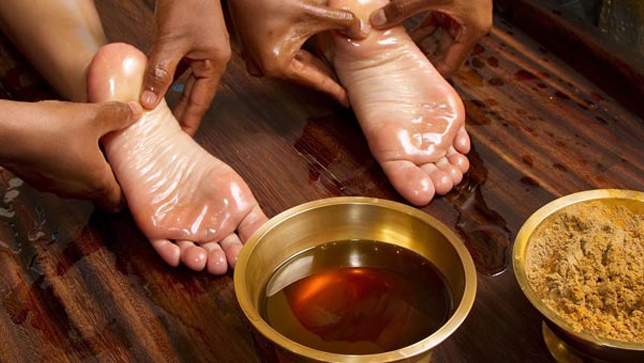Why Ayurveda Is So Popular In Kerala
Kerala Ayurveda treatments aim to balance the doshas, or life energy, in your body. Depending on your Doshas and body disposition, different Ayurvedic treatment

Ayurveda, sometimes known as the "science of life and longevity," is thousands of years older than any other healing system in the world. Since then, Ayurveda has become a symbol for the positive development of humanity on all levels, including the physical, mental, and spiritual. Ayurveda is a complete naturalistic medical system based on the diagnosis of your body's humours (vata, pitta, and kapha) to attain equilibrium. Ayurvedic medicine focuses mostly on stopping health problems before they start. Healing is secondary to prevention. Ayurveda posits that a person becomes ill when one or more of the Tridoshas (Vata, Pitta, and Kapha) make unbalanced or unpredictable function, leading to organ dysfunction. In addition to the Tridoshic doshas, Ayurveda also emphasises the importance of harmony between the five elements of the universe: air, water, fire, earth, and ether.

Indic scholars first developed rveda in India some 5,000 years ago. Ayurveda was India's primary medicinal system for hundreds of years. Kerala's relative seclusion has allowed Ayurveda to flourish even while its popularity elsewhere in India has waned over the decades. Ayurveda's spiritual home is in Kerala.

Kerala's Ayurvedic tradition is unparalleled, even by international standards. Because of its pleasant environment and wealth of native herbs, Kerala is an ideal destination for those seeking the restorative effects of Ayurvedic treatment. The monsoon season (June–November) in Kerala is perfect for rejuvenation therapy. When it's cold and wet outside, people's pores open up, allowing the oils from herbs to work more effectively. Due to the low temperature swings between day and night, the body experiences minimal stress during the monsoon season. In addition, the treatment benefits from the rain's ability to clear the air of dust. There are around four million annual visitors to India seeking Ayurvedic therapy. Travellers from far and wide flock to Kerala in the hopes of receiving a rejuvenating or healing Ayurveda treatment.

Herbs and medicinal plants can be grown easily in the wild because to the favourable temperature and the abundance of forests and mountains in the area. The growth of Ayurveda therapies in Kerala might be attributed to the state's well-developed healthcare infrastructure and abundance of trained Ayurveda doctors.
For hundreds of years, people in Kerala who were seeking treatment for any illness were limited to consulting Ayurveda Vaidyas (traditional practitioners of Ayurveda). Traditional practitioners, or Vaidyas, were essential in the development of Ayurveda in the state, particularly the fabled Ashtavaidyas, who were known for their miraculous healing touch. For hundreds of years, the Ashtavaidyas and their successors administered healthcare to the entire state. Since they were their communities' only access to healthcare, the Vaidyas of Kerala were tasked with translating Ayurvedic theory into practise. As a result, the majority of modern Ayurvedic practises and protocols have originated in or near Kerala. Ayurveda is more than a medical practise in Kerala; it permeates the entire culture and forms the basis of daily living. Traditional physicians in Kerala known as Ashtavaidyas have played a significant role in the state of Kerala's ascent to prominence as a centre for Ayurveda. Historically, Ayurveda practises based on texts and regional folk medicine practises utilising Kerala's rich medicinal flora have interacted, resulting in the distinctive Ashtavaidya tradition. Only a small number of the original Ashtavaidya families—just 18—are still active in the State today.
Another important reason in Kerala's rise to scientific preeminence was the region's rich Sanskrit tradition. In reality, the common man in Kerala is very familiar with the words of Ashtangahridayam, the Ayurvedic book. A select group of Brahmin families, known as Ashtavaidyas, were responsible for preserving the Ayurvedic heritage by providing Ayurvedic health treatment and passing on the tenets of Ayurveda through the special gurukula system of education. Ashtangahridaya was revered as a foundational work by traditional Ayurvedic practitioners. Experts in their fields have provided multiple commentaries. Moreover, new literature in both Malayalam and Sanskrit were penned in the state of Kerala. Some examples might be Sahasrayogam, Chikilsamanjari, or Vaidyamanorama. These books, along with others like them from Kerala, continue to be valuable resources for learning about medicinal herbs and treatments. The Ottamoolichikitsa, or single-drug therapies, of Kerala's Vaidyas has been shown to be highly effective, even for chronic conditions. The continuation and development of panchakarma therapy is another major achievement of Keralan medical professionals. This therapeutic resource was preserved in its entirety in Kerala, even as it faded away elsewhere in the country for political and social reasons. The panchakarma treatment modalities' prevalence has grown in recent years alongside Ayurveda's rising popularity. Ayurveda is more than just a medical practise. It is both a scientific discipline and a philosophy. In a nutshell, Ayurveda teaches its followers the ins and outs of living a healthy, happy, and pleasant life on all levels: physical, mental, and spiritual. Prevention is emphasised as being preferable than treatment. Greens Ayurveda is the place to go in Kerala for Ayurvedic services and education. To reach us immediately, please dial +91 496 2504334.













